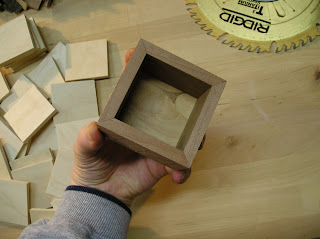It was a busy week at the office, but I was able to work in a little shop time during the evenings in preparation for this weekend’s glue-up project. First I set up a straight edge fence along the front of the bench.
I used the fence to line up the box parts and tape them together.
I used blue painters tape because of the good holding strength and it has a bit of “stretchiness” that creates a nice tight grip when the box parts are “rolled” up. Here’s a shot of the tester box with one of the bottoms dry fitted into the groove.
I was ready to start gluing up the box parts when I discovered what happens when Titebond III is stored in very cold climates. This was not an issue in New Mexico!
Even after trying to let the bottle warm up a bit in the house the glue was still a chunky, gloppy mess.
This put me off track for a couple days until I could pick up some more Titebond, but I did get all the box pieces taped up and ready for glue.
After re-stocking the glue supply I decided to bring the show into the house. I set up a small table in the family room, fired up “A Fistful of Dollars” on the DVR and got to work.
Once all the glue was placed, I “rolled” up each box around the bottom piece and taped the last corner into place.
It is key to make sure that last corner is pulled together with some tension in the tape. This really holds the four corners together tightly while the glue cures at each joint and locks the bottom piece into place.
After each box was glued and taped, I checked them for square and then set them aside for about 20 minutes. That time allowed any glue that squeezed out of the joints to start drying and getting gummy. I then removed any excess glue with a chisel…a much better process than leaving it too long and allowing it to harden completely…a lesson I learned the hard way on the last set I boxes!
Overall, I’m very happy with the progress on these boxes. They checked out well with the machinist’s square after they were glued and taped. Many of the chalk markings were blurred, wiped off or covered with tape, so there will be little chore in getting them sorted again. There are some slight variations in size for small groupings that will impact the sizing of the lids, but I think those can be sorted out fairly easily.
Next up…taking this whole herd of 35 boxes and adding the corner splines, cutting and fitting lids and completing the final details and finish. I still need to build the spline cutting jig for the table saw...hopefully by the end of this weekend. I may end up breaking the gang up so that I can finish a small group and get them sent off to Maryland for the silent auction fund raiser.
I shoveled a light dusting of a couple inches of snow. Hopefully a little warm up is on the docket for tomorrow. I’m ready for a little New Mexico to show up here in Minnesota…brrr!
Pete
































































